Navigation
Install the app
How to install the app on iOS
How To Use Progressive Web App aka PWA On 420 Magazine Forum
Note: This feature may not be available in some browsers.
More options
You are using an out of date browser. It may not display this or other websites correctly.
You should upgrade or use an alternative browser.
You should upgrade or use an alternative browser.
Doc Bud: All Organic OG Kush SCROG
- Thread starter Doc Bud
- Start date
- Thread starter
- #362
Doc, how late into flower do you feel that you can safely foliar feed without risk of moldy buds?
Depends on what you're feeding.
Compost tea right up to the last week of bloom. The calcium/mineral feed popular in the high brix methods right up to the end.
The reason is that these products have active microbes that alter the pH of the leaves, kill PM and botyritis, etc.
I would not feed a Cal/mag solution or a "green up" type of feeding once the buds are well developed.
I've been spraying mine weekly with worm tea, right up to the last week before I cut them down. No issues whatsoever.
Caveat: My environment is good. If your temps and/or RH is out of line, who knows what evil thing may transpire?
hey bro!
I wait till there are 5 sets of leaves and the top the plant just above the second node. This method will give you 4 nice colas.
Two colas can be made by topping at the 4th node, but there will also be smaller branches underneath, which you can cleanup later.
Hey Thanks Doc Bud. Doing a half and half grow this time. Half of the tent will be topped for 4 colas. The other half will be a 10 plant SOG. I will let them have only one cola. Think I'll stick around and watch you anyway. Peace Bro!
- Thread starter
- #364
OG update! I estimate 10-14 days till harvest right now. They should start to really put on weight now.....
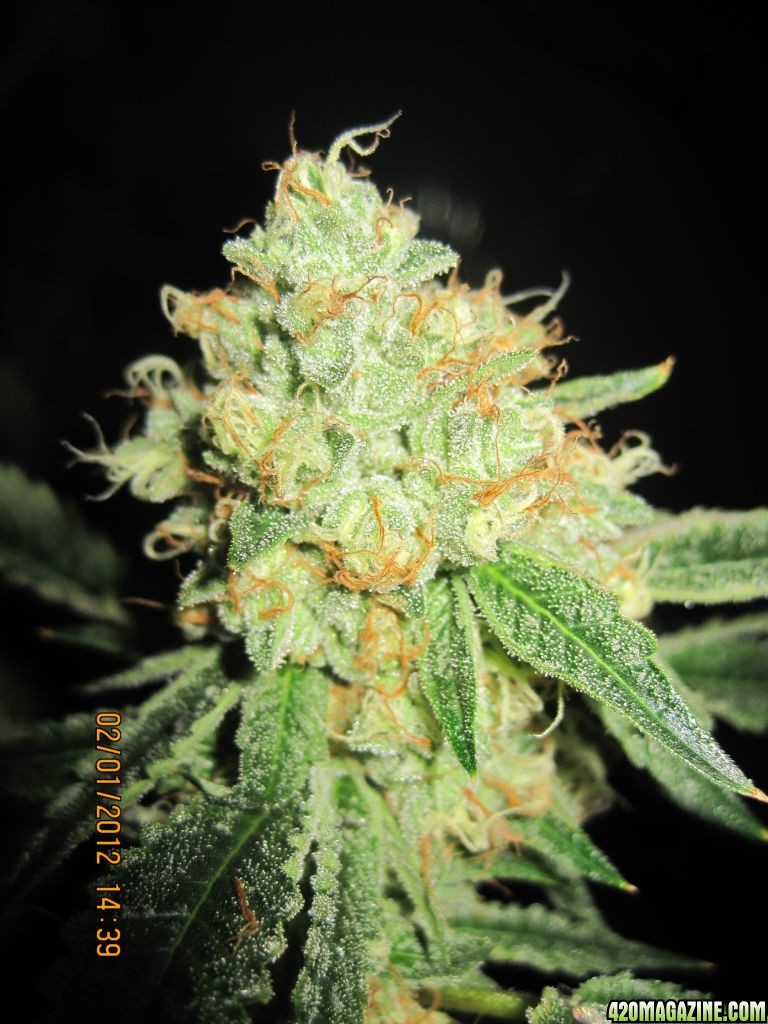
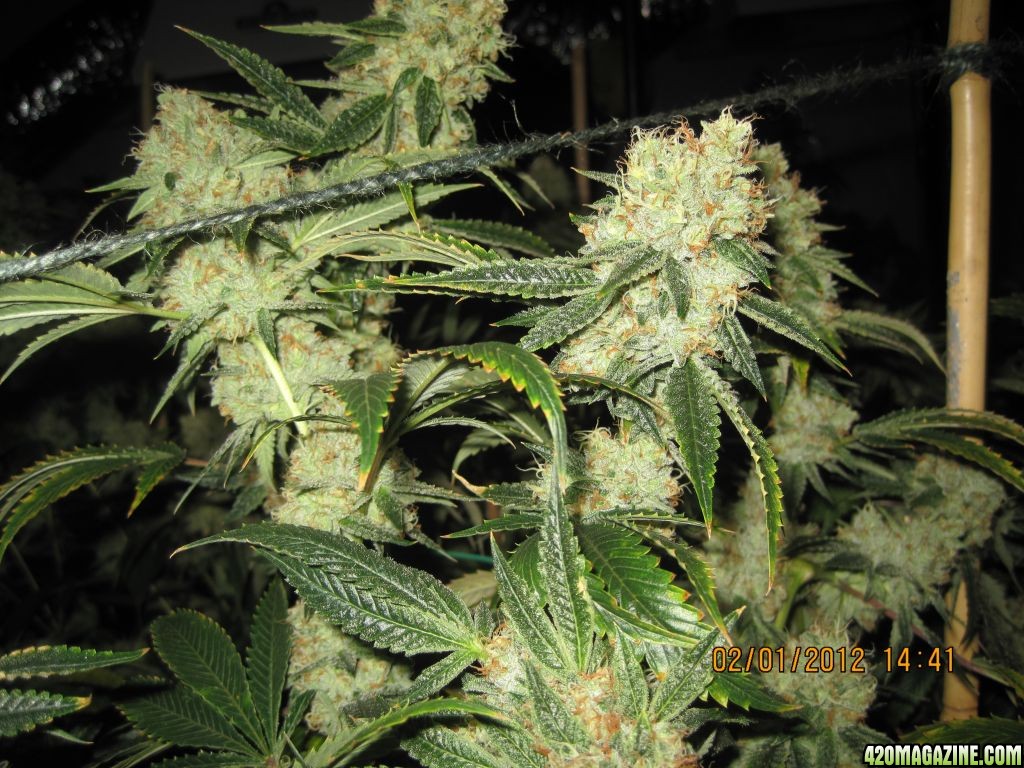
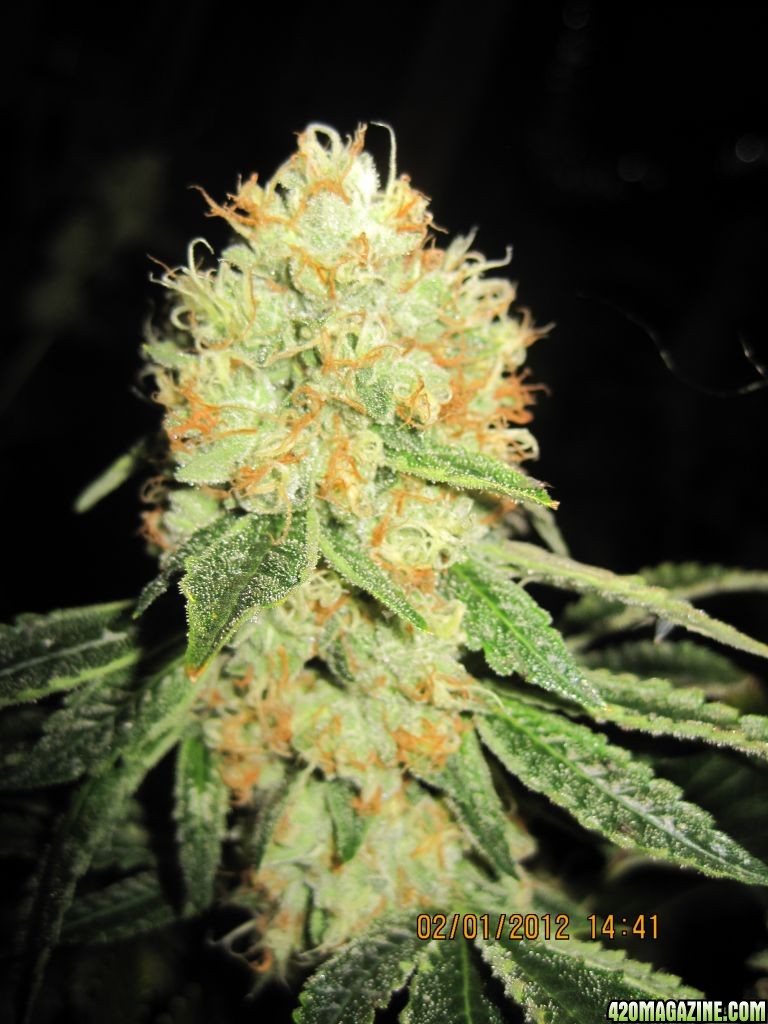
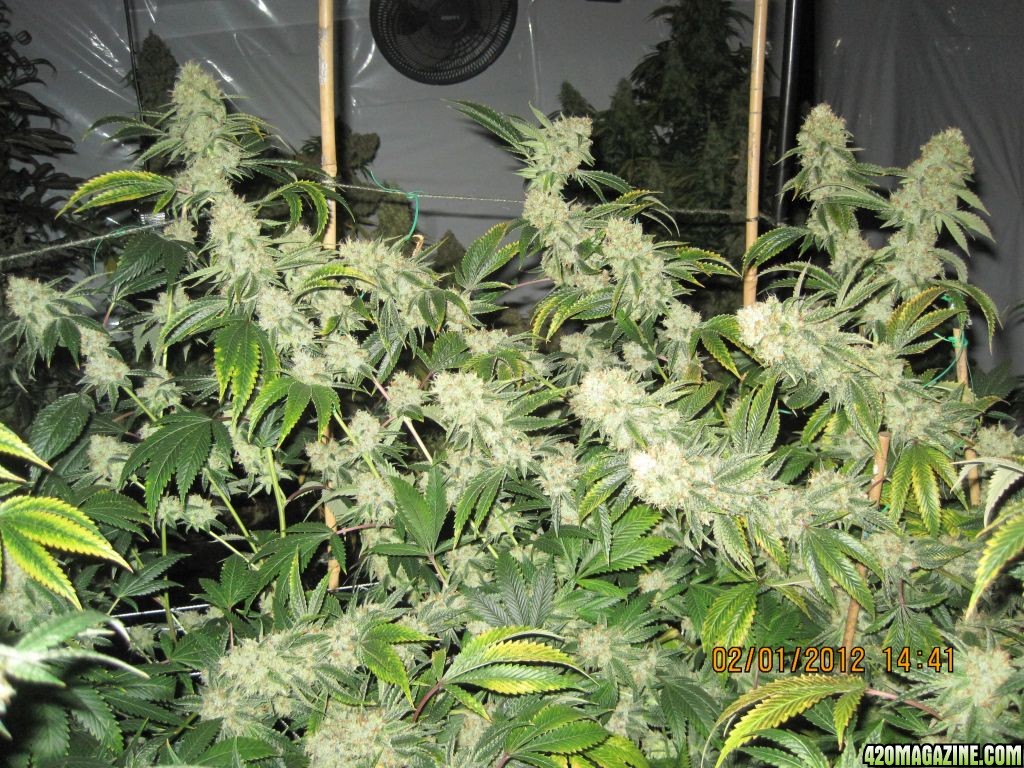
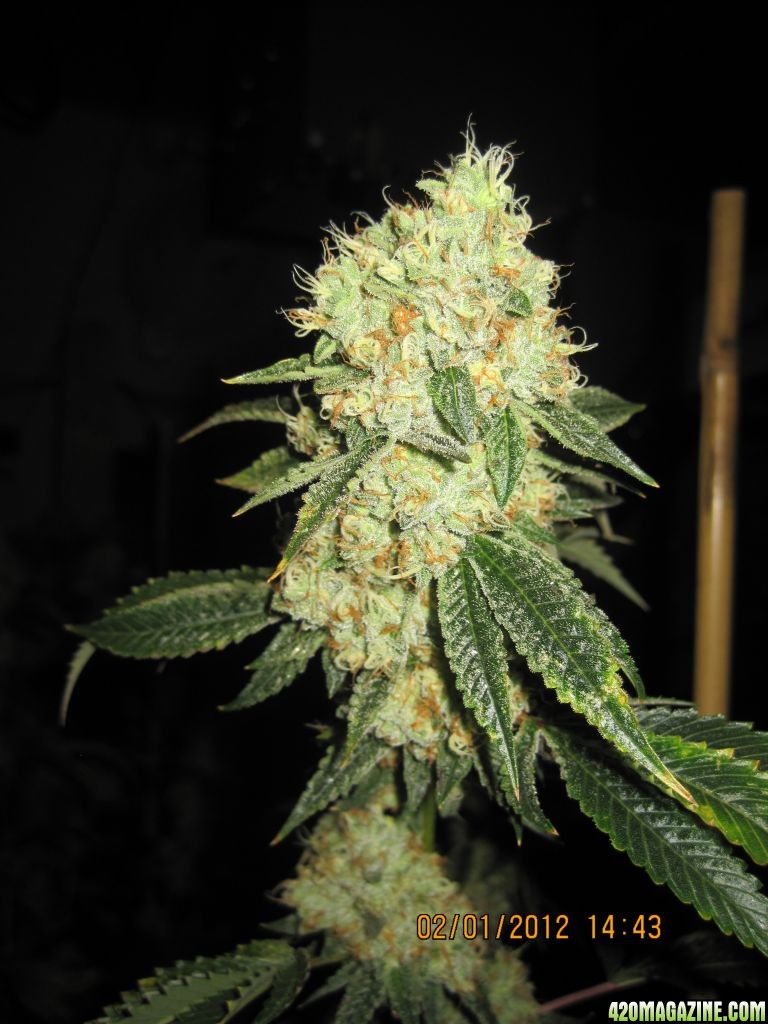
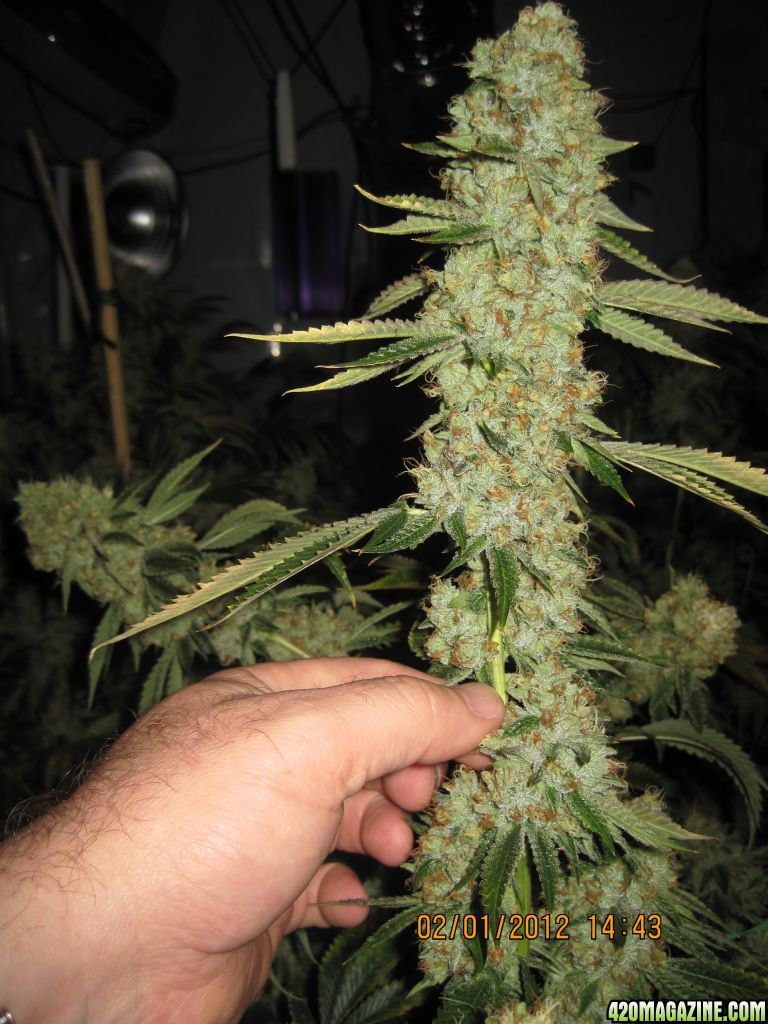
What would you rather have for Valentine's Day? A rose, or one of these?
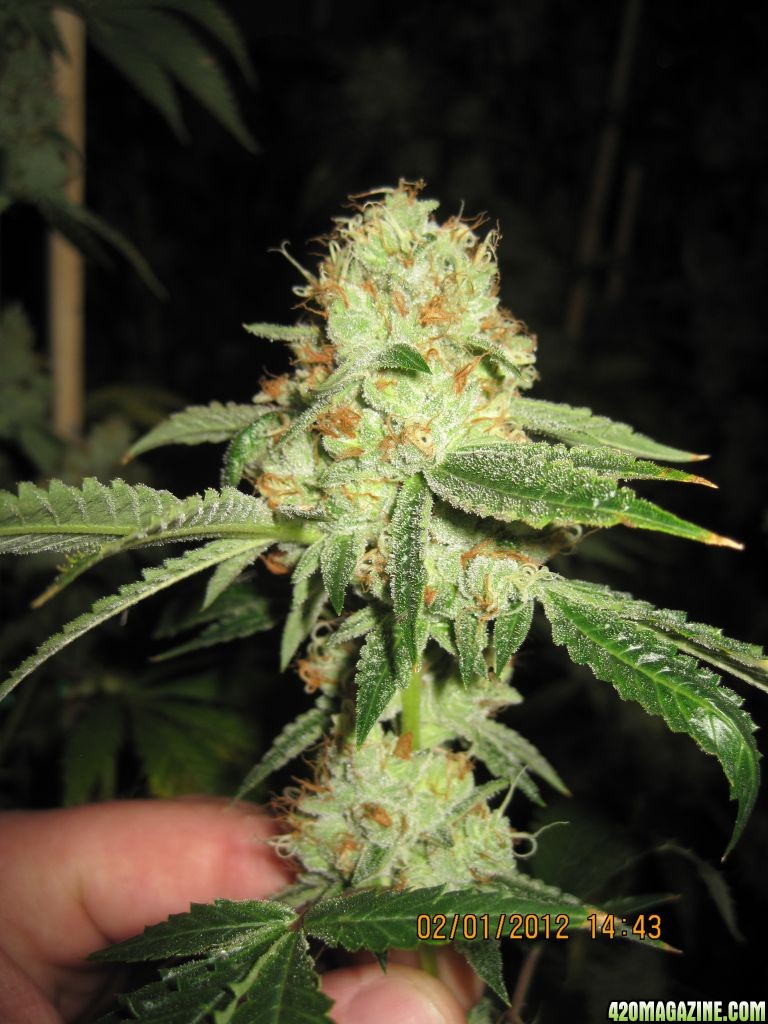
New Zealand Purple Kush. Delicious. These are coming down this Friday. Even the large fan leaves are frosty. The buds are sticky, gooey and dense as can be.
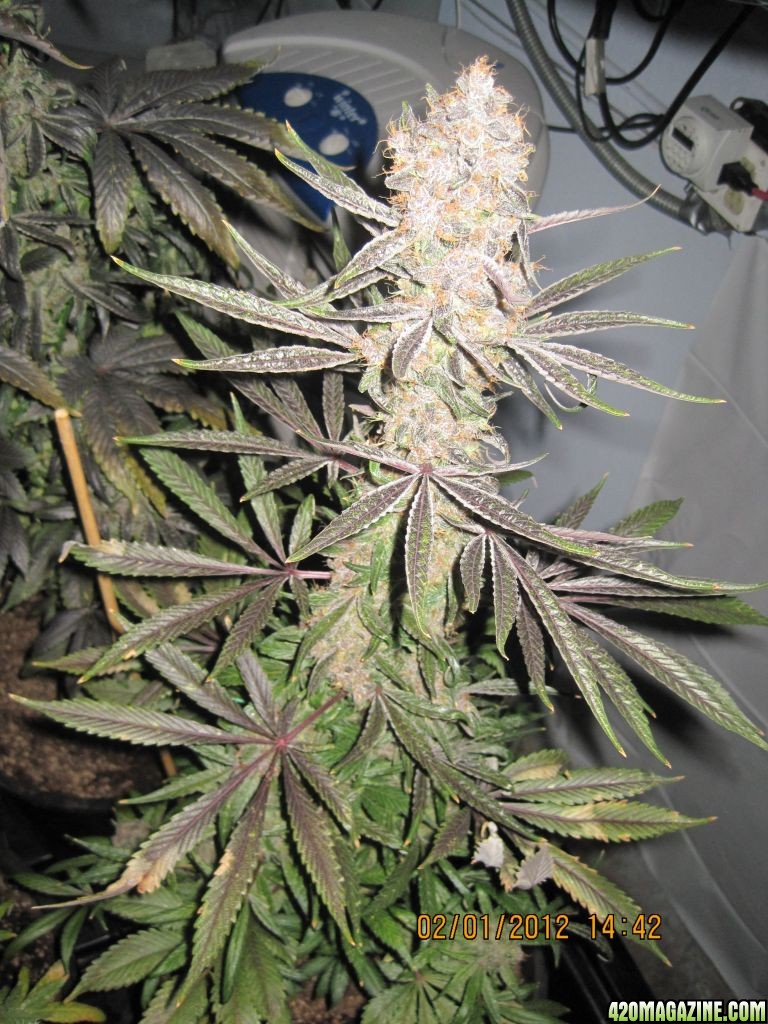
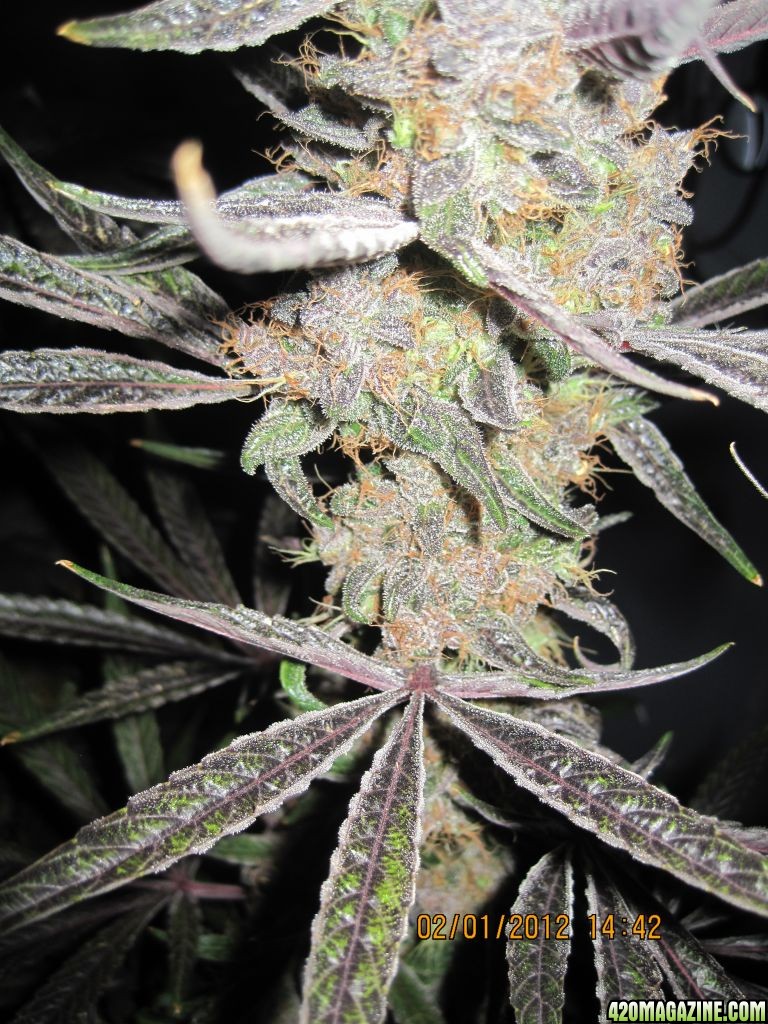
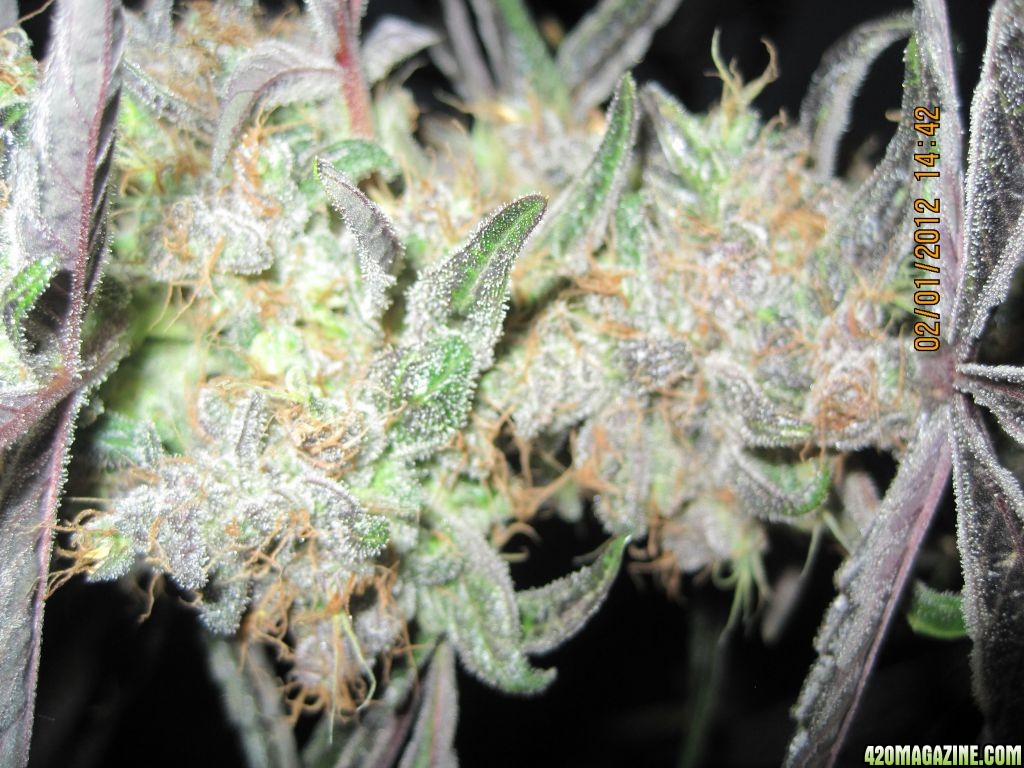
Chocolate Kush
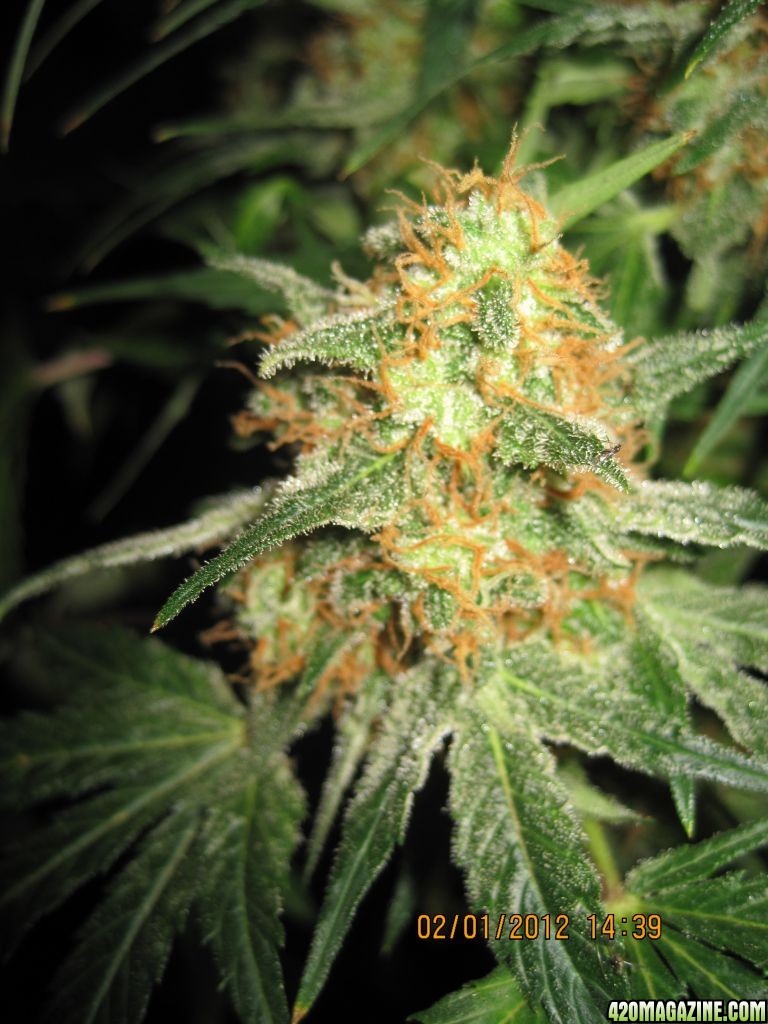
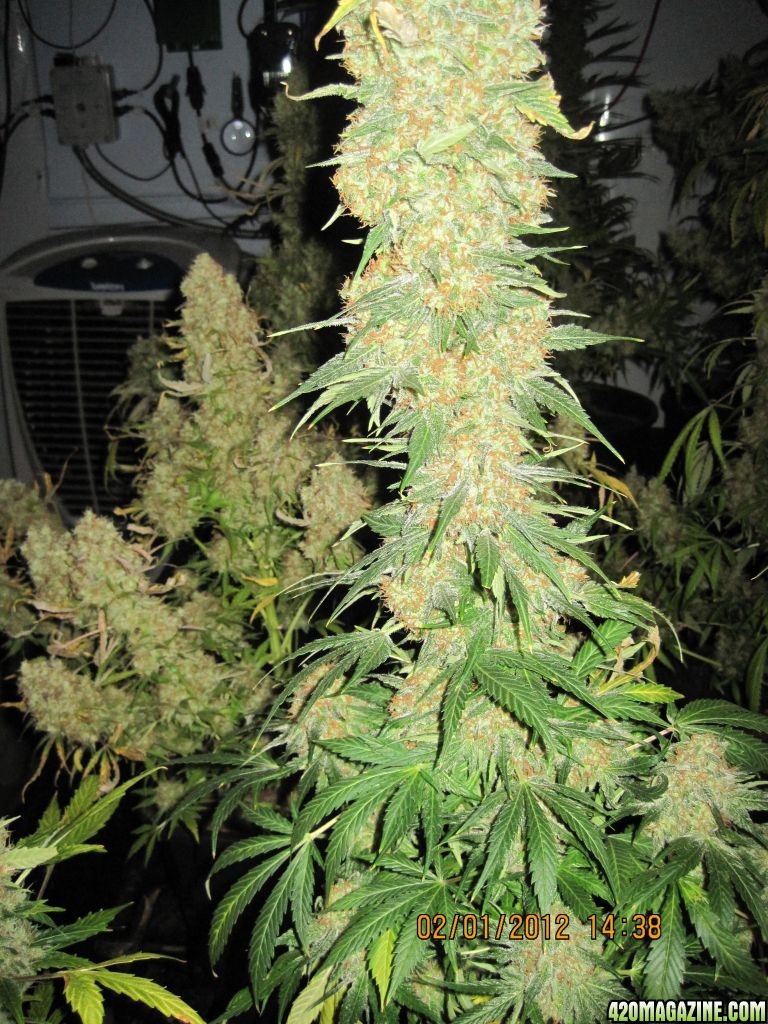
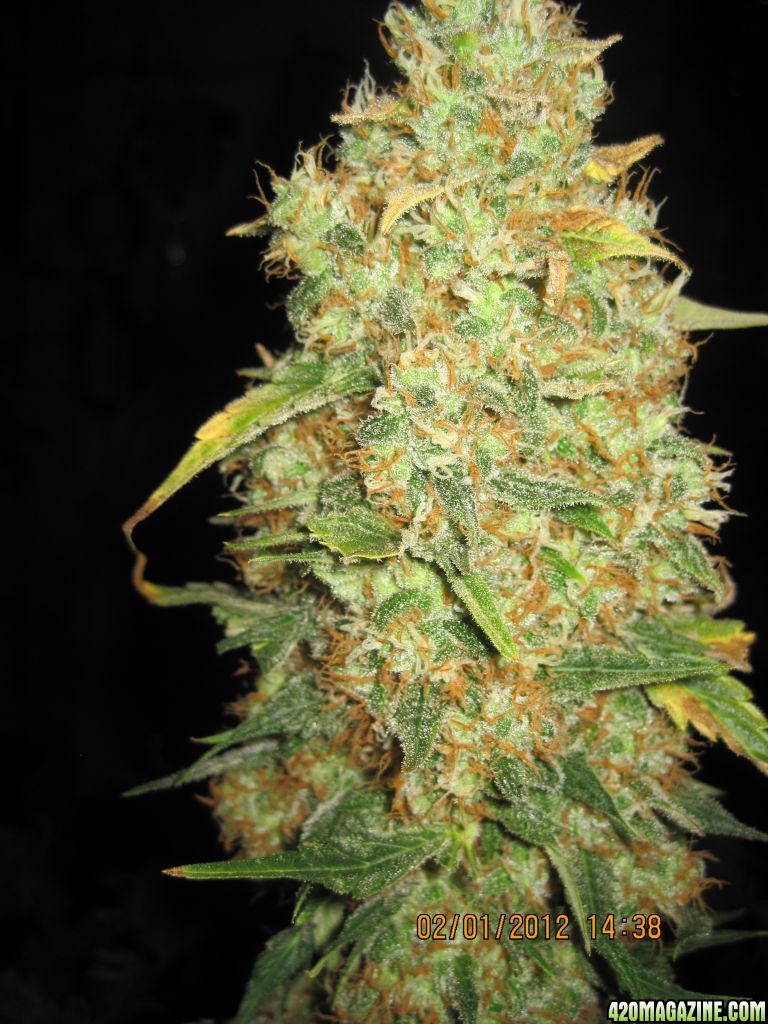
Nug shots of Lemon Thai. Best flavor of anything I've ever had....second best effect. Only the Columbian beats it as far as the high goes. But I'll re-check it after it's cured a couple weeks.
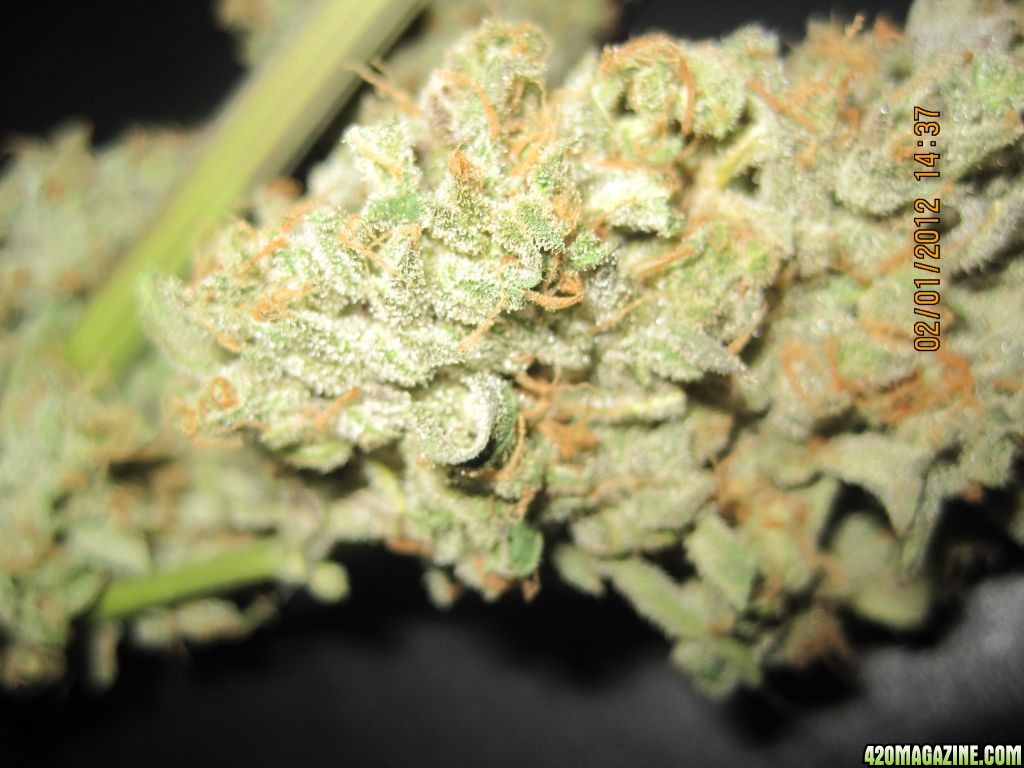
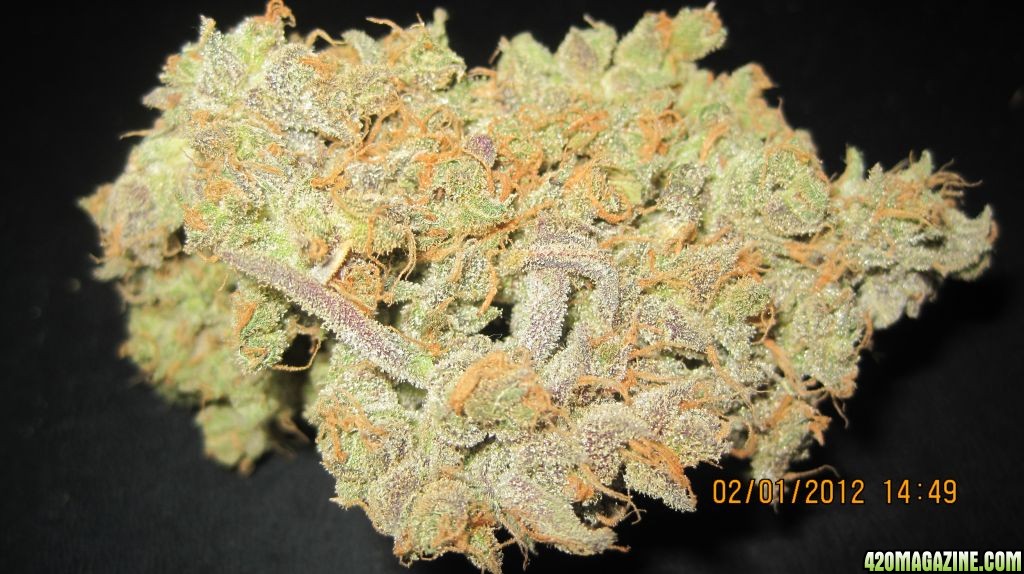
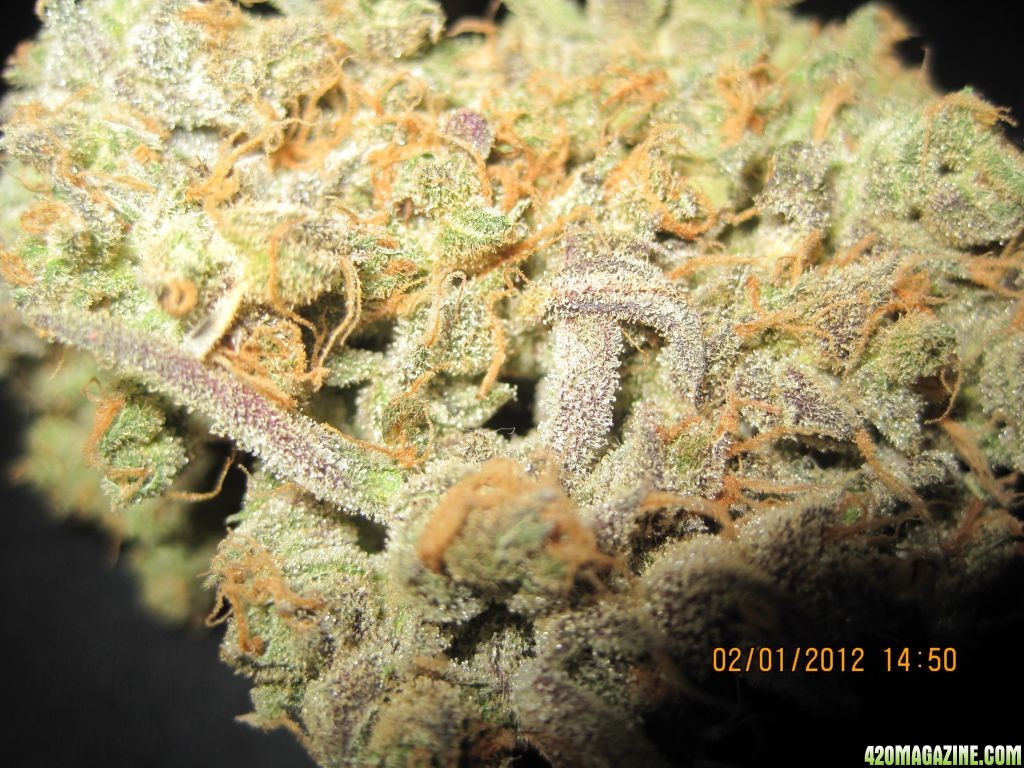
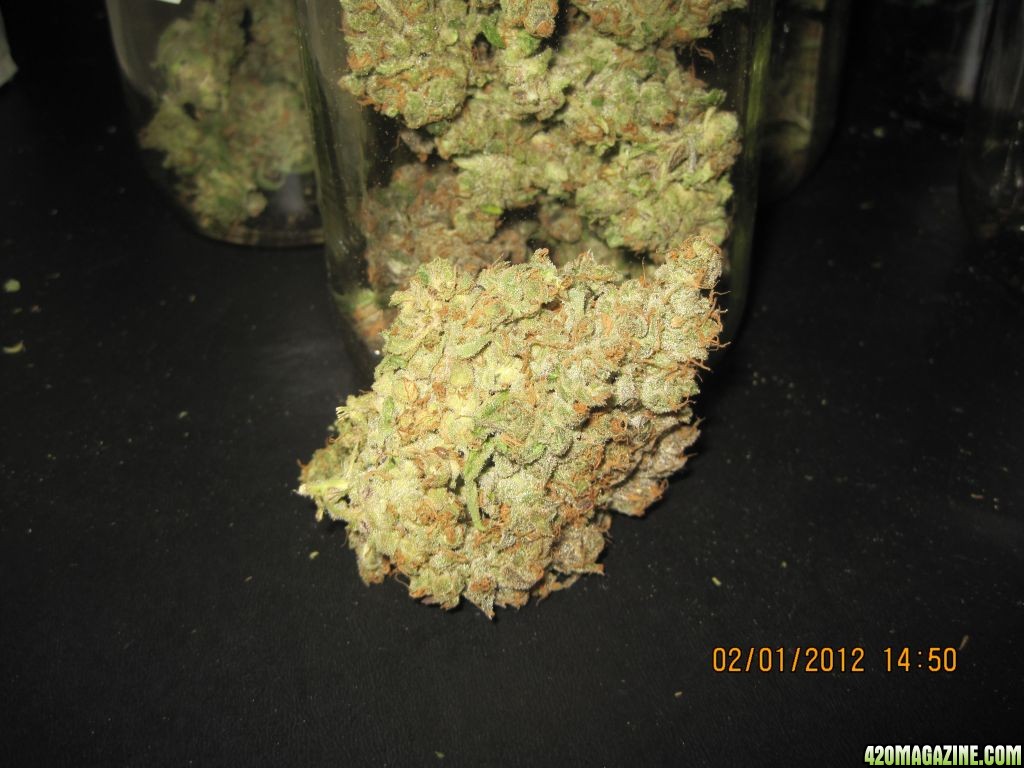
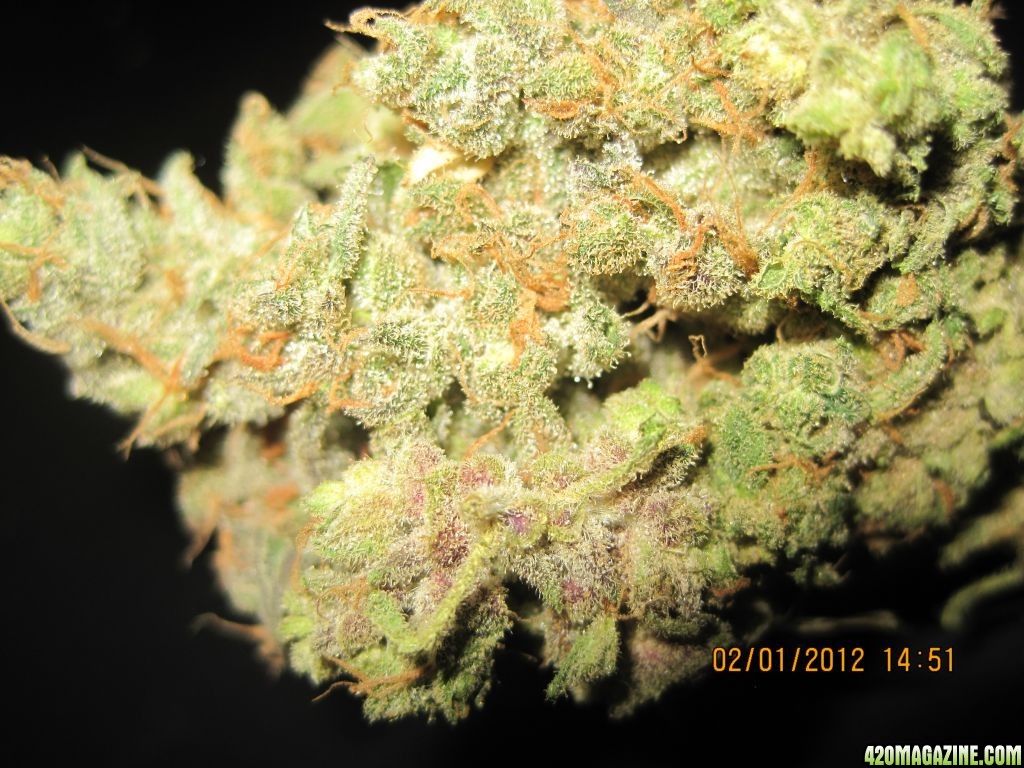
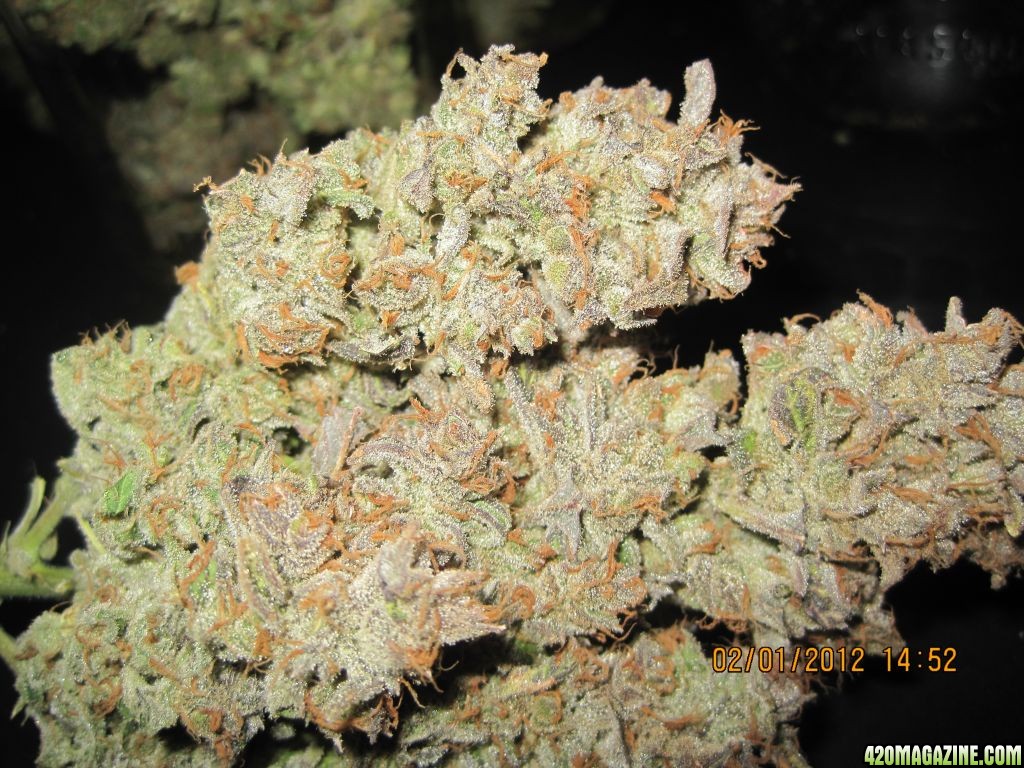
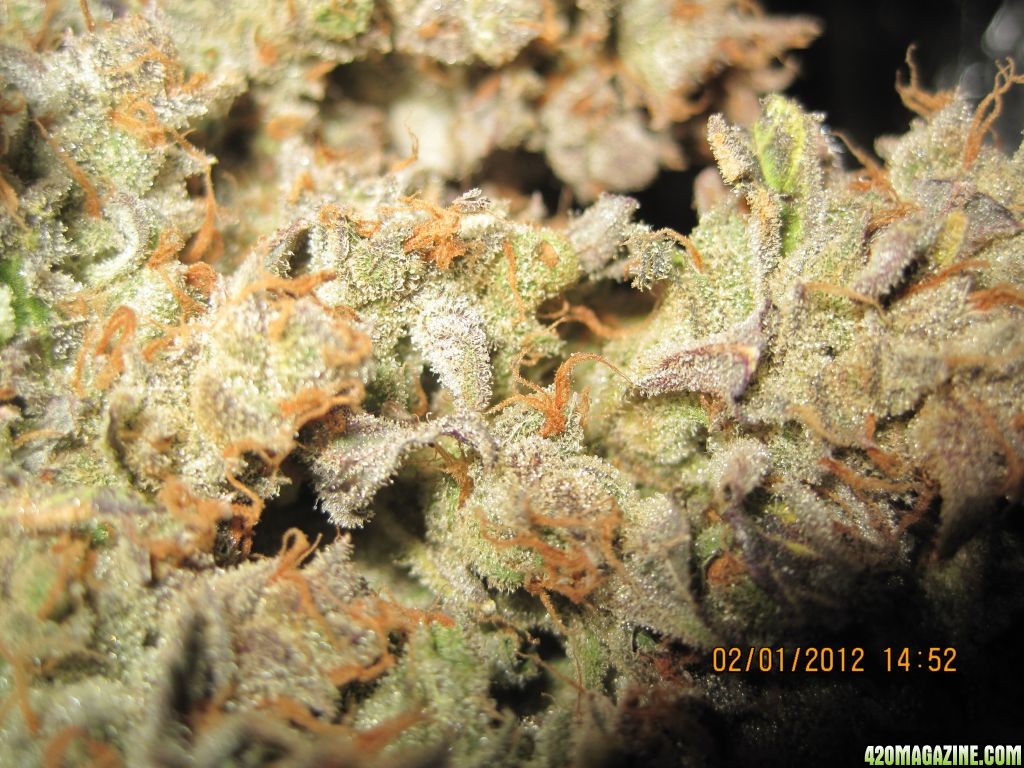
What would you rather have for Valentine's Day? A rose, or one of these?
New Zealand Purple Kush. Delicious. These are coming down this Friday. Even the large fan leaves are frosty. The buds are sticky, gooey and dense as can be.
Chocolate Kush
Nug shots of Lemon Thai. Best flavor of anything I've ever had....second best effect. Only the Columbian beats it as far as the high goes. But I'll re-check it after it's cured a couple weeks.

What would you rather have for Valentine's Day? A rose, or one of these?
I'll be your valentine Doc!


I swear every time you update I think...that's it, this is as good as weed gets...but then somehow each time you outdo yourself.
 If this is what organics does i'm all-in!
If this is what organics does i'm all-in! 
So just to be clear... you're still spraying that cola down with teas? I wasn't sure how far into bloom to go either.


All of those above photos and different varieties look amazing!! That Chocolate Kush cola is a monster!! wow and the purple kush, those leafs look like painted art!!
Also curious about fratdoggs question, are you spraying the cola's or just the foliage and undersides?
Also curious about fratdoggs question, are you spraying the cola's or just the foliage and undersides?
OrganicTreees
New Member
I can't stop drooling over your plants doc, that new zealand kush is something else, but the lemon thai buds just look so perfect. I'm dreaming of how wonderful it would smell to break one open and bask in the goeyness 
I'd have to say this is my favorite journal going right now

I'd have to say this is my favorite journal going right now
- Thread starter
- #368
I'll be your valentine Doc!
I swear every time you update I think...that's it, this is as good as weed gets...but then somehow each time you outdo yourself.If this is what organics does i'm all-in!
So just to be clear... you're still spraying that cola down with teas? I wasn't sure how far into bloom to go either.

Just wait! It's gonna get even better....just wait. Yes, these colas are being sprayed down with tea. I don't try to saturate the buds, but the certainly get wet. I spray the canopy till it gets drippy, like it just rained, and then spray the underside.
No bugs. No chemicals. No PM or rot. You've got to use a brand new, biologically active tea!
All of those above photos and different varieties look amazing!! That Chocolate Kush cola is a monster!! wow and the purple kush, those leafs look like painted art!!
Also curious about fratdoggs question, are you spraying the cola's or just the foliage and undersides?
See above. Yep, they get sprayed. I don't try to spray the cola's, but they definitely get wet.
I can't stop drooling over your plants doc, that new zealand kush is something else, but the lemon thai buds just look so perfect. I'm dreaming of how wonderful it would smell to break one open and bask in the goeyness
I'd have to say this is my favorite journal going right now
Thanks for the compliments! The Lemon Thai is special. The buds are on par with Jack Herer as far as density goes, which is unusual for an equatorial Sativa.
The smell is lemony, sunny, floral and delicious! The smoke leaves the edges of your tongue coated with a lemony, smokey, sweet aftertaste. It's very pronounced. The effect is very upbeat, wide-awake, but calm and peaceful at the same time. Very happy, sunny, and silly. At the same time it does NOT give you the munchies that much, like the Columbian does.
The NZ PK is going to be very interesting. It has the most distinctive purple-chocolate smell, the buds are the most dense I've seen, except the lemon paki I grew recently, and they have a very nice purple color.
Next up:
(Blue Dream x Sour Diesel) x Blue Dream x Blue Dream x Blue Dream.
Lemon Paki
Jack Herer x NZ Purple Kush
some indica I haven't sorted out yet.
I sent in a sample of my supersoil to International Ag Labs for testing. They will tell me exactly what I need to do to tweak it for High Brix. So the next grow is going to feature:
High Brix methods, from seedling to harvest! Minerals, teas, foliar sprays, nutrient drenches......alll with a view to increase EC, CE, Active microbes, and Brix.
I predict the best results to date are in the near future.
onegramperwat
New Member
Amazing colas Doc! Im getting anxious, my super soil has 28 days to go.
High Brix Student
High Brix Student
OrganicTreees
New Member
you're doing some amazing things in that garden I can't wait to see the results of your soil testing 

Doc,
If I use a pre mixed organic like Peace of mind, or Dr. Earth, do I still need to let the soil set 30 days before using it?
If I use a pre mixed organic like Peace of mind, or Dr. Earth, do I still need to let the soil set 30 days before using it?
good night! doc those sound and look amazing!

- Thread starter
- #373
Doc,
If I use a pre mixed organic like Peace of mind, or Dr. Earth, do I still need to let the soil set 30 days before using it?
Not really. The soil "cooks" for 30 days in order to give the microbes a chance to establish themselves and begin breaking things down. It also give the pH a chance to balance out and the Ca and P a chance to find eachother and mate up.
I'm adding all kinds of rock powder and organic material that needs to digest before the plants can use it, so I have to cook mine.
The main thing is to keep the EC and CE of the soil where it belongs and to establish a very robust soil biology. If you decide to add the rock powders, then you'll want the soil to cook.
good night! doc those sound and look amazing!
Thanks!
FrankFoster
New Member
"Disease-Inducing Soils. In this type of soil, plant pathogenic microorganisms such as Fusarium fungi can comprise 5 to 20 percent of the total microflora if fresh organic matter with a high nitrogen content is applied to such a soil, incompletely oxidized products can arise that are malodorous and toxic to growing plants. Such soils tend to cause frequent infestations of disease organisms, and harmful insects. Thus, the application of fresh organic matter to these soils is often harmful to crops. Probably more than 90 percent of the agricultural land devoted to crop production worldwide can be classified as having disease-inducing soil. Such soils generally have poor physical properties, and large amounts of energy are lost as "greenhouse" gases, particularly in the case of rice fields. Plant nutrients are also subject to immobilization into unavailable forms.
Disease-Suppressive Soils. The microflora of disease-suppressive soils is usually dominated by antagonistic microorganisms that produce copious amounts of antibiotics. These include fungi of the genera Penicillium, Trichoderma, and Aspergillus, and actinomycetes of the genus Streptomyces. The antibiotics they produce can have biostatic and biocidal effects on soil-borne plant pathogens, including Fusarium which would have an incidence in these soils of less than 5 percent. Crops planted in these soils are rarely affected by diseases or insect pests. Even if fresh organic matter with a high nitrogen content is applied, the production of putrescent substances is very low and the soil has a pleasant earthy odor after the organic matter is decomposed. These soils generally have excellent physical properties; for example, they readily, form water-stable aggregates and they are well-aerated, and have a high permeability to both air and water. Crop yields in the disease-suppressive soils are often slightly lower than those in synthetic soils. Highly acceptable crop yields are obtained whenever a soil has a predominance of both disease-suppressive and synthetic microorganisms.
Zymogenic Soils. These soils are dominated by a microflora that can perform useful kinds of fermentations, i.e., the breakdown of complex organic molecules into simple organic substances and inorganic materials. The organisms can be either obligate or facultative anaerobes. Such fermentation-producing microorganisms often comprise the microflora of various organic materials, i.e., crop residues, animal manures, green manures and municipal wastes including composts. After these amendments are applied to the soil, their number: and fermentative activities can increase dramatically and overwhelm the indigenous soil microflora for an indefinite period. While these microorganisms remain predominant, the soil can be classified as a zymogenic soil which is generally characterized by a) pleasant, fermentative odors especially after tillage, b) favorable soil physical properties (e.g., Increased aggregate stability, permeability, aeration and decreased resistance to tillage c) large amounts of inorganic nutrients, amino acids, carbohydrates, vitamins and other bioactive substances which can directly or indirectly enhance the growth, yield and quality of crops, d) low occupancy of Fusarium fungi which is usually less than 5 percent, and e) low production of greenhouse gases (e.g., methane, ammonia, and carbon dioxide) from croplands, even where flooded rice is grown.
Synthetic Soils. These soils contain significant populations of microorganisms which are able to fix atmospheric nitrogen and carbon dioxide into complex molecules such as amino acids, proteins and carbohydrates. Such microorganisms include photosynthetic bacteria which perform incomplete photosynthesis anaerobically, certain Phycomycetes (fungi that resemble algae), and both green algae and blue--green algae which function aerobically. All of these are photosynthetic organisms that fix atmospheric nitrogen. If the water content of these soils is stable, their fertility can be largely maintained by regular additions of only small amounts of organic materials. These soils have a low Fusarium occupancy and they are often of the disease-suppressive type. The production of gases from fields where synthetic soils are present is minimal, even for flooded rice."
A nice breakdown of the micro-organisms you are looking for in your BRIX method would be great doc. I started watering in the mice-organisms into my outside garden for summer tomatoes...
Disease-Suppressive Soils. The microflora of disease-suppressive soils is usually dominated by antagonistic microorganisms that produce copious amounts of antibiotics. These include fungi of the genera Penicillium, Trichoderma, and Aspergillus, and actinomycetes of the genus Streptomyces. The antibiotics they produce can have biostatic and biocidal effects on soil-borne plant pathogens, including Fusarium which would have an incidence in these soils of less than 5 percent. Crops planted in these soils are rarely affected by diseases or insect pests. Even if fresh organic matter with a high nitrogen content is applied, the production of putrescent substances is very low and the soil has a pleasant earthy odor after the organic matter is decomposed. These soils generally have excellent physical properties; for example, they readily, form water-stable aggregates and they are well-aerated, and have a high permeability to both air and water. Crop yields in the disease-suppressive soils are often slightly lower than those in synthetic soils. Highly acceptable crop yields are obtained whenever a soil has a predominance of both disease-suppressive and synthetic microorganisms.
Zymogenic Soils. These soils are dominated by a microflora that can perform useful kinds of fermentations, i.e., the breakdown of complex organic molecules into simple organic substances and inorganic materials. The organisms can be either obligate or facultative anaerobes. Such fermentation-producing microorganisms often comprise the microflora of various organic materials, i.e., crop residues, animal manures, green manures and municipal wastes including composts. After these amendments are applied to the soil, their number: and fermentative activities can increase dramatically and overwhelm the indigenous soil microflora for an indefinite period. While these microorganisms remain predominant, the soil can be classified as a zymogenic soil which is generally characterized by a) pleasant, fermentative odors especially after tillage, b) favorable soil physical properties (e.g., Increased aggregate stability, permeability, aeration and decreased resistance to tillage c) large amounts of inorganic nutrients, amino acids, carbohydrates, vitamins and other bioactive substances which can directly or indirectly enhance the growth, yield and quality of crops, d) low occupancy of Fusarium fungi which is usually less than 5 percent, and e) low production of greenhouse gases (e.g., methane, ammonia, and carbon dioxide) from croplands, even where flooded rice is grown.
Synthetic Soils. These soils contain significant populations of microorganisms which are able to fix atmospheric nitrogen and carbon dioxide into complex molecules such as amino acids, proteins and carbohydrates. Such microorganisms include photosynthetic bacteria which perform incomplete photosynthesis anaerobically, certain Phycomycetes (fungi that resemble algae), and both green algae and blue--green algae which function aerobically. All of these are photosynthetic organisms that fix atmospheric nitrogen. If the water content of these soils is stable, their fertility can be largely maintained by regular additions of only small amounts of organic materials. These soils have a low Fusarium occupancy and they are often of the disease-suppressive type. The production of gases from fields where synthetic soils are present is minimal, even for flooded rice."
A nice breakdown of the micro-organisms you are looking for in your BRIX method would be great doc. I started watering in the mice-organisms into my outside garden for summer tomatoes...
- Thread starter
- #375
"Disease-Inducing Soils. In this type of soil, plant pathogenic microorganisms such as Fusarium fungi can comprise 5 to 20 percent of the total microflora if fresh organic matter with a high nitrogen content is applied to such a soil, incompletely oxidized products can arise that are malodorous and toxic to growing plants. Such soils tend to cause frequent infestations of disease organisms, and harmful insects. Thus, the application of fresh organic matter to these soils is often harmful to crops. Probably more than 90 percent of the agricultural land devoted to crop production worldwide can be classified as having disease-inducing soil. Such soils generally have poor physical properties, and large amounts of energy are lost as "greenhouse" gases, particularly in the case of rice fields. Plant nutrients are also subject to immobilization into unavailable forms.
Disease-Suppressive Soils. The microflora of disease-suppressive soils is usually dominated by antagonistic microorganisms that produce copious amounts of antibiotics. These include fungi of the genera Penicillium, Trichoderma, and Aspergillus, and actinomycetes of the genus Streptomyces. The antibiotics they produce can have biostatic and biocidal effects on soil-borne plant pathogens, including Fusarium which would have an incidence in these soils of less than 5 percent. Crops planted in these soils are rarely affected by diseases or insect pests. Even if fresh organic matter with a high nitrogen content is applied, the production of putrescent substances is very low and the soil has a pleasant earthy odor after the organic matter is decomposed. These soils generally have excellent physical properties; for example, they readily, form water-stable aggregates and they are well-aerated, and have a high permeability to both air and water. Crop yields in the disease-suppressive soils are often slightly lower than those in synthetic soils. Highly acceptable crop yields are obtained whenever a soil has a predominance of both disease-suppressive and synthetic microorganisms.
Zymogenic Soils. These soils are dominated by a microflora that can perform useful kinds of fermentations, i.e., the breakdown of complex organic molecules into simple organic substances and inorganic materials. The organisms can be either obligate or facultative anaerobes. Such fermentation-producing microorganisms often comprise the microflora of various organic materials, i.e., crop residues, animal manures, green manures and municipal wastes including composts. After these amendments are applied to the soil, their number: and fermentative activities can increase dramatically and overwhelm the indigenous soil microflora for an indefinite period. While these microorganisms remain predominant, the soil can be classified as a zymogenic soil which is generally characterized by a) pleasant, fermentative odors especially after tillage, b) favorable soil physical properties (e.g., Increased aggregate stability, permeability, aeration and decreased resistance to tillage c) large amounts of inorganic nutrients, amino acids, carbohydrates, vitamins and other bioactive substances which can directly or indirectly enhance the growth, yield and quality of crops, d) low occupancy of Fusarium fungi which is usually less than 5 percent, and e) low production of greenhouse gases (e.g., methane, ammonia, and carbon dioxide) from croplands, even where flooded rice is grown.
Synthetic Soils. These soils contain significant populations of microorganisms which are able to fix atmospheric nitrogen and carbon dioxide into complex molecules such as amino acids, proteins and carbohydrates. Such microorganisms include photosynthetic bacteria which perform incomplete photosynthesis anaerobically, certain Phycomycetes (fungi that resemble algae), and both green algae and blue--green algae which function aerobically. All of these are photosynthetic organisms that fix atmospheric nitrogen. If the water content of these soils is stable, their fertility can be largely maintained by regular additions of only small amounts of organic materials. These soils have a low Fusarium occupancy and they are often of the disease-suppressive type. The production of gases from fields where synthetic soils are present is minimal, even for flooded rice."
A nice breakdown of the micro-organisms you are looking for in your BRIX method would be great doc. I started watering in the mice-organisms into my outside garden for summer tomatoes...
Good stuff bro! There are many bacteria we're looking for, as well as fungi. The most well known fungus is Trichoderma.....as you know.
A well designed microbial tea brewed properly will do the job.....no need to know the taxonomy of all the different microbes---or even the correct pronunciation---as long as you've got a quality tea and a well mineralized soil.
As soon as we start getting some rain, I'm going to get my vegetable garden supercharged with the rock powders and microbes. I can't wait.
Ole Smoker
New Member
Doc,
I have been researching HB for some time and buy most of my organics from Fedco in Maine. As to the soft rock phosphate they list this:
Phosphate, Calphos Colloidal (0-2-0, 18% P: 2% readily available, 21% Ca, trace minerals) This soft-rock phosphate is an excellent choice for calcium-deficient soils as plants will take up the calcium first, freeing the phosphorus to be taken up in turn. Don't apply lime at the same time lest plants take calcium from the lime leaving the phosphate not yet available. Colloidal phosphate contains fine clays which help sandy soils retain water and nutrients. Use combined with green manures for soil rebuilding, or by itself to give plants immediate doses of nutrients.
I'm leaning to add the lime into the bottom 2/3 so the roots in the upper 1/3 can release the phosphates. It's nice to see others excited about the prospects of HB. I'm along on this ride....and thanks.
I have been researching HB for some time and buy most of my organics from Fedco in Maine. As to the soft rock phosphate they list this:
Phosphate, Calphos Colloidal (0-2-0, 18% P: 2% readily available, 21% Ca, trace minerals) This soft-rock phosphate is an excellent choice for calcium-deficient soils as plants will take up the calcium first, freeing the phosphorus to be taken up in turn. Don't apply lime at the same time lest plants take calcium from the lime leaving the phosphate not yet available. Colloidal phosphate contains fine clays which help sandy soils retain water and nutrients. Use combined with green manures for soil rebuilding, or by itself to give plants immediate doses of nutrients.
I'm leaning to add the lime into the bottom 2/3 so the roots in the upper 1/3 can release the phosphates. It's nice to see others excited about the prospects of HB. I'm along on this ride....and thanks.
- Thread starter
- #377
Doc,
I have been researching HB for some time and buy most of my organics from Fedco in Maine. As to the soft rock phosphate they list this:
Phosphate, Calphos Colloidal (0-2-0, 18% P: 2% readily available, 21% Ca, trace minerals) This soft-rock phosphate is an excellent choice for calcium-deficient soils as plants will take up the calcium first, freeing the phosphorus to be taken up in turn. Don’t apply lime at the same time lest plants take calcium from the lime leaving the phosphate not yet available. Colloidal phosphate contains fine clays which help sandy soils retain water and nutrients. Use combined with green manures for soil rebuilding, or by itself to give plants immediate doses of nutrients.
I'm leaning to add the lime into the bottom 2/3 so the roots in the upper 1/3 can release the phosphates. It's nice to see others excited about the prospects of HB. I'm along on this ride....and thanks.
Interesting! That's exactly how I would have looked at it not long ago. But not anymore.....
I'm adding limestone, gypsum and Calphos all at the same time, exactly because I don't want all that phosphate available. I want the Cations from the Ca to mate up with the Anions from the phosphate.
Basically, you want to turn your soil into a rechargable battery.
The Nutritional Foundation of the High Brix Garden Program is Soil Remineralization
Soil remineralization is accomplished through the annual broadcast. The annual broadcast is custom formulated based upon the results of the soil test. It is formulated from the following broad categories.
Calcium-based rock powders
Calcium is present in every biological cell. It must be well supplied in order for the soil to produce top-quality. Limestone and gypsum are frequently used from this group.
Clay-based rock powders
The best in this class is soft rock phosphate. Soft rock phosphate provides many trace nutrients in addition to phosphates. These trace minerals are in a compound colloid form. Soft rock phosphate combines with limestone to form an electromagnetic field within the soil that helps soil resist water and wind erosion.
Silicate-based rock powders
Silica is on of the most often-neglected plant nutrients. It is extremely important for plant growth and in maintaining soil energy. Silicate rock powders are a virtual storehouse of broad-spectrum trace minerals. They also help increase soil paramagnetism. This type of rock powder requires microbial digestion to make the locked up nutrients available to the plants.
Carbon-based powders
These are very important energy sources that support soil microbiology. Carbon powders help balance calcium-based powders and make both the calcium and the carbon more accessible in the soil. Carbons help increase crop growth through the respiration of carbon dioxide that results from their digestion in the soil. Lastly carbon increases soil energy by increasing the ionization flow of nutrients in the magnetic lines of force.
Fertilizers for specific nutrients in short supply
It does very little good to address all the broad-spectrum rare earth minerals without first addressing the major plant nutrients such as nitrogen, phosphorous, and potassium and the common trace minerals such as copper, iron, zinc, and manganese. Examples of fertilizers in this group would include potassium sulfate and copper sulfate. Fertilizers are only used when called for by the soil test.

So bottom line: we're not adding things in order to make nutrients available to the plants! We're adding massive amounts of calcium and phosphorus in specific ratio's in order to mineralize the soil for the benefits of the microbes.
It's hard to break away from feeding the plant.....but that's what is needed. We want to feed the soil. The soil will feed the plant far better than we can.
The soil needs an abundance of calcium.....far more than any other element. The Ca/phos ratio Ca/mag ratio, Phos/pot ratio are very, very important.....not for the plants, but for the microbes, CE and soil energy.
This is definitely beyond mere organics.
FrankFoster
New Member
I see what you are meaning here and it seems to be working...
How are you looking at the soil to see the bacterium?
I was reading in
"Mycorrhizae: Sustainable Agriculture and Forestry
By Zaki Anwar Siddiqui, Mohd. Sayeed Akhtar, Kazuyoshi Futai"
that the research is moving forward on the issue of finding mycrorrhizae fungus symbioses in places where mining tailings have poisoned the area but plants still grow, finding those mycorrhizae would result in adapted ones (gene lines) that use up heavy metals faster than their counterparts. And that certain bacteria help with this process better when the mycorrhizae is established on the roots first them the bacteria is applied.
This is illuminated by your produce and particular soil that continually has both soluble and non-soluble NPK running it through 24/7, or for example using them in chemical hydro = better stable ph and water.
Further; This brix method does result in a culture growing very close to your produce and recommendations suggest a washing of all produce before consumption....
What different things have you considered in this respect; Application of a microscopic bacteria onto produce that is smoked??? And what "clean" practices eliminate this. Water curing was the only one I could find that might help this thing out...
your thoughts?
How are you looking at the soil to see the bacterium?
I was reading in
"Mycorrhizae: Sustainable Agriculture and Forestry
By Zaki Anwar Siddiqui, Mohd. Sayeed Akhtar, Kazuyoshi Futai"
that the research is moving forward on the issue of finding mycrorrhizae fungus symbioses in places where mining tailings have poisoned the area but plants still grow, finding those mycorrhizae would result in adapted ones (gene lines) that use up heavy metals faster than their counterparts. And that certain bacteria help with this process better when the mycorrhizae is established on the roots first them the bacteria is applied.
This is illuminated by your produce and particular soil that continually has both soluble and non-soluble NPK running it through 24/7, or for example using them in chemical hydro = better stable ph and water.
Further; This brix method does result in a culture growing very close to your produce and recommendations suggest a washing of all produce before consumption....
What different things have you considered in this respect; Application of a microscopic bacteria onto produce that is smoked??? And what "clean" practices eliminate this. Water curing was the only one I could find that might help this thing out...
your thoughts?
- Thread starter
- #379
I see what you are meaning here and it seems to be working...
How are you looking at the soil to see the bacterium?
I was reading in
"Mycorrhizae: Sustainable Agriculture and Forestry
By Zaki Anwar Siddiqui, Mohd. Sayeed Akhtar, Kazuyoshi Futai"
that the research is moving forward on the issue of finding mycrorrhizae fungus symbioses in places where mining tailings have poisoned the area but plants still grow, finding those mycorrhizae would result in adapted ones (gene lines) that use up heavy metals faster than their counterparts. And that certain bacteria help with this process better when the mycorrhizae is established on the roots first them the bacteria is applied.
This is illuminated by your produce and particular soil that continually has both soluble and non-soluble NPK running it through 24/7, or for example using them in chemical hydro = better stable ph and water.
Further; This brix method does result in a culture growing very close to your produce and recommendations suggest a washing of all produce before consumption....
What different things have you considered in this respect; Application of a microscopic bacteria onto produce that is smoked??? And what "clean" practices eliminate this. Water curing was the only one I could find that might help this thing out...
your thoughts?
The bacteria that I spray on the leaves soaks in to the leaf because of the Saponin in the Yucca Extract. What doesn't soak in either drips off, or after the water evaporates it just dies.
These bacteria are not pathogenic and do not present any health hazards at all, hence the universal agreement among bureaucrats and busy-bodies that these products are safe to use at home and in commercial production of food crops.
Of far more concern would be the spraying of plants with pesticides, miticides and fungicides......and of course the act of smoking produce with powdery mildew,etc.
Weekly spraying of microbial teas and mineral is nothing to be concerned about.
Having said that, I do stop the spraying roughly 2 weeks before harvest. I doubt there's much residue there.
Doc,
Here is what I just loaded up in a bucket for my next grow.
4 gl ProMix Organic, 1/2 gl perlite, 1/4 cup gypsum, 1/4 cup Azomite, 2tbsp epsom, 1/2 tsp Borax
6 tbsp Peace-of-Mind Tomato organic 7-4-5 (they were out of all purpose 5-5-5)
I watered it with a gallon of Stump Tea and Molasses. I will let it set until the next vegged lady is ready for action.
I hope to only add the Stump Tea, Molasses, and SnowSormUltra.
Should this be enough to get by with? Budget is low and I don't want to have to buy much more.
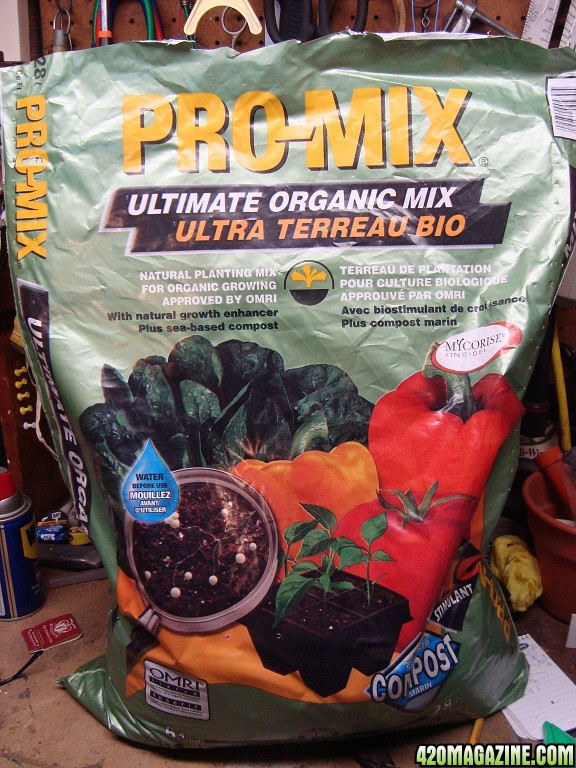
COMPONENTS:
Canadian Sphagnum Peat Moss
(65-75% by volume)
Sea-based Compost (from composted shrimp shells & seaweed)
Limestone (for pH adjustment)
Perlite
Mycorise® - endomycorrhizae inoculant

Bring Life To Your Roots With Stump Tea!!!
At HTG Supply, our employees are constantly searching for better ways to grow for our customers; and it was through this research that a direct relationship with the manufacturer of extremely high-quality products blossomed to produce Stump Tea, a one of a kind root enhancer! With this revolutionary ready-made brew, gardeners can now enjoy the proven benefits of compost tea in an instant liquid form (just add water)!
Stump Tea is a special blend of soil biology and beneficial Mycorrhizae that occurs naturally in the some of the world's most pristine forests. This synergistic mix vigorously inoculates the root zone and boosts metabolic rate by colonizing the roots with billions of "little helpers" that increase root size and production which in turn increases yields! Stump Tea not only has a great mix of biology, but it also incorporates soil conditioners and a few other natural ingredients to make one killer tea. Humic and fulvic acids aid in the uptake of micro and macro nutrients. Molasses feeds the biology so it can thrive. Kelp is an excellent source of natural micro and macro nutrients that are very easy for plants to take in. With all of the key elements that make up a great tea in one instant mix, Stump Tea has done all of the work for you, and ensures a perfect brew every time. Stump Tea is a proven, time-tested recipe that will impress even the most experienced of tea connoisseurs!
Stump Tea Benefits:
100% safe and natural ingredents create healthier plants
Contains beneficial enzymes
Helps to produce very lush, deep green plants
Aids in the breakdown of nutrients for plant absorption
Increases water retenton and enhances nutrient uptake
Enhances the taste of fruits and vegetables (raises brix levels)
Increases nutrient cycling in the rhizosphere (area around the roots)
Helps plants deal with enviromental stresses better, including heat stress and disease (great for fighting harmful fungus)
Breaks down toxins in soil and on plants
Here is what I just loaded up in a bucket for my next grow.
4 gl ProMix Organic, 1/2 gl perlite, 1/4 cup gypsum, 1/4 cup Azomite, 2tbsp epsom, 1/2 tsp Borax
6 tbsp Peace-of-Mind Tomato organic 7-4-5 (they were out of all purpose 5-5-5)
I watered it with a gallon of Stump Tea and Molasses. I will let it set until the next vegged lady is ready for action.
I hope to only add the Stump Tea, Molasses, and SnowSormUltra.
Should this be enough to get by with? Budget is low and I don't want to have to buy much more.

COMPONENTS:
Canadian Sphagnum Peat Moss
(65-75% by volume)
Sea-based Compost (from composted shrimp shells & seaweed)
Limestone (for pH adjustment)
Perlite
Mycorise® - endomycorrhizae inoculant

Bring Life To Your Roots With Stump Tea!!!
At HTG Supply, our employees are constantly searching for better ways to grow for our customers; and it was through this research that a direct relationship with the manufacturer of extremely high-quality products blossomed to produce Stump Tea, a one of a kind root enhancer! With this revolutionary ready-made brew, gardeners can now enjoy the proven benefits of compost tea in an instant liquid form (just add water)!
Stump Tea is a special blend of soil biology and beneficial Mycorrhizae that occurs naturally in the some of the world's most pristine forests. This synergistic mix vigorously inoculates the root zone and boosts metabolic rate by colonizing the roots with billions of "little helpers" that increase root size and production which in turn increases yields! Stump Tea not only has a great mix of biology, but it also incorporates soil conditioners and a few other natural ingredients to make one killer tea. Humic and fulvic acids aid in the uptake of micro and macro nutrients. Molasses feeds the biology so it can thrive. Kelp is an excellent source of natural micro and macro nutrients that are very easy for plants to take in. With all of the key elements that make up a great tea in one instant mix, Stump Tea has done all of the work for you, and ensures a perfect brew every time. Stump Tea is a proven, time-tested recipe that will impress even the most experienced of tea connoisseurs!
Stump Tea Benefits:
100% safe and natural ingredents create healthier plants
Contains beneficial enzymes
Helps to produce very lush, deep green plants
Aids in the breakdown of nutrients for plant absorption
Increases water retenton and enhances nutrient uptake
Enhances the taste of fruits and vegetables (raises brix levels)
Increases nutrient cycling in the rhizosphere (area around the roots)
Helps plants deal with enviromental stresses better, including heat stress and disease (great for fighting harmful fungus)
Breaks down toxins in soil and on plants
Similar threads
- Replies
- 346
- Views
- 58K
- Replies
- 71
- Views
- 5K
- Replies
- 501
- Views
- 73K
- Replies
- 646
- Views
- 52K
- Replies
- 124
- Views
- 14K


